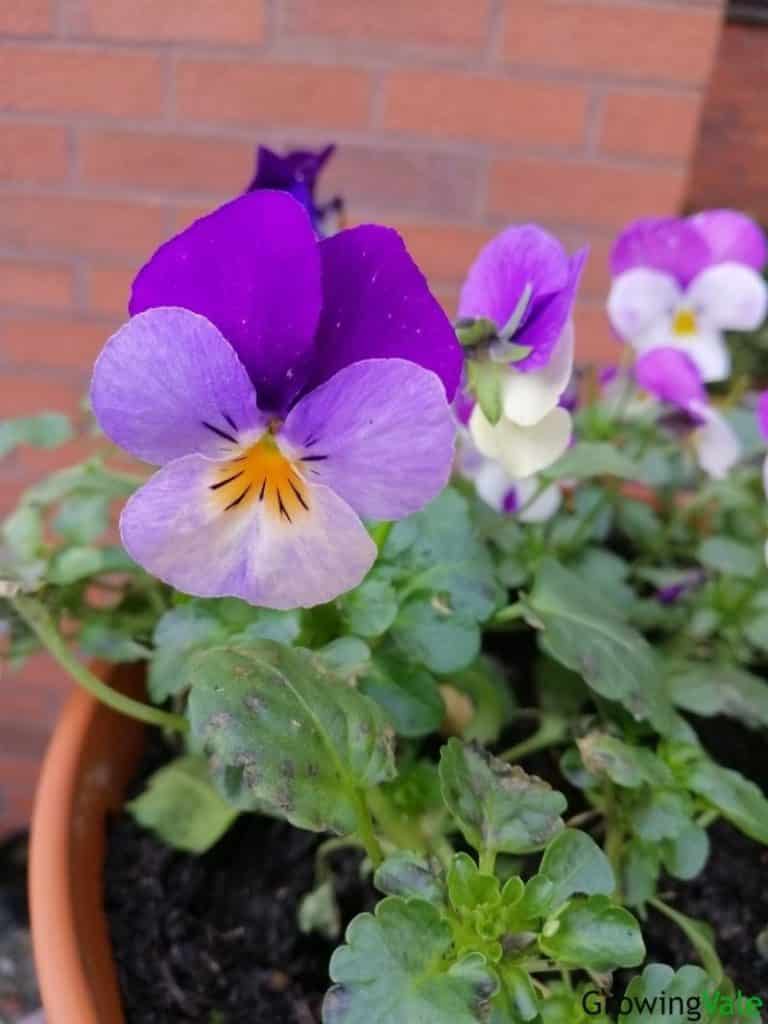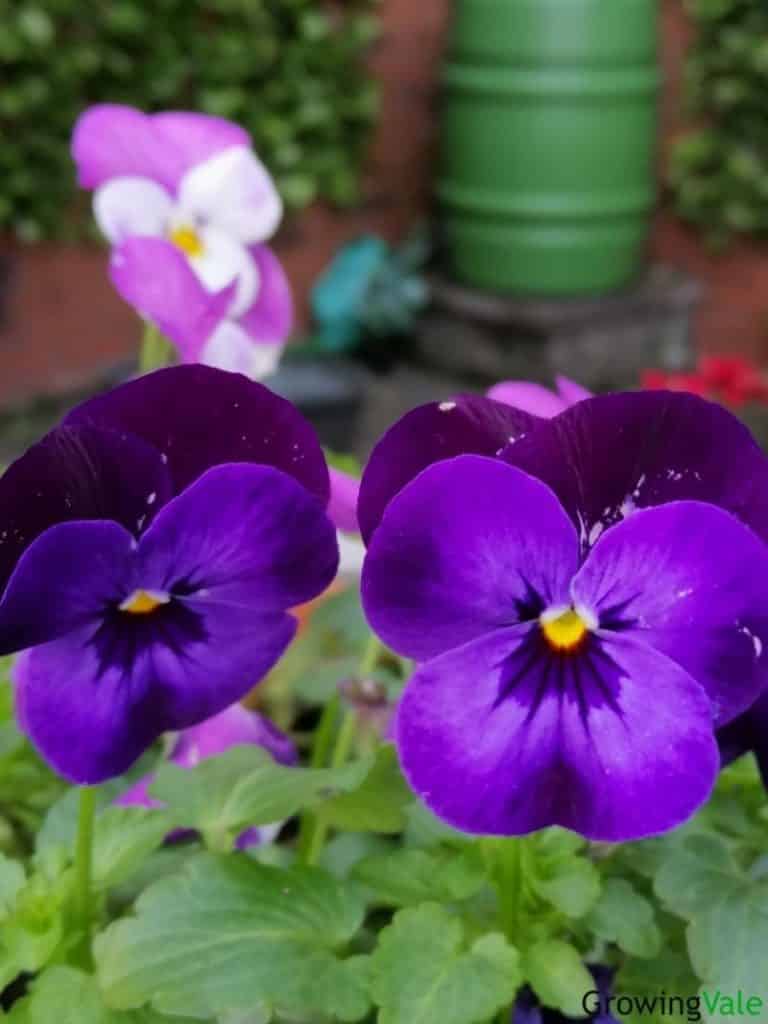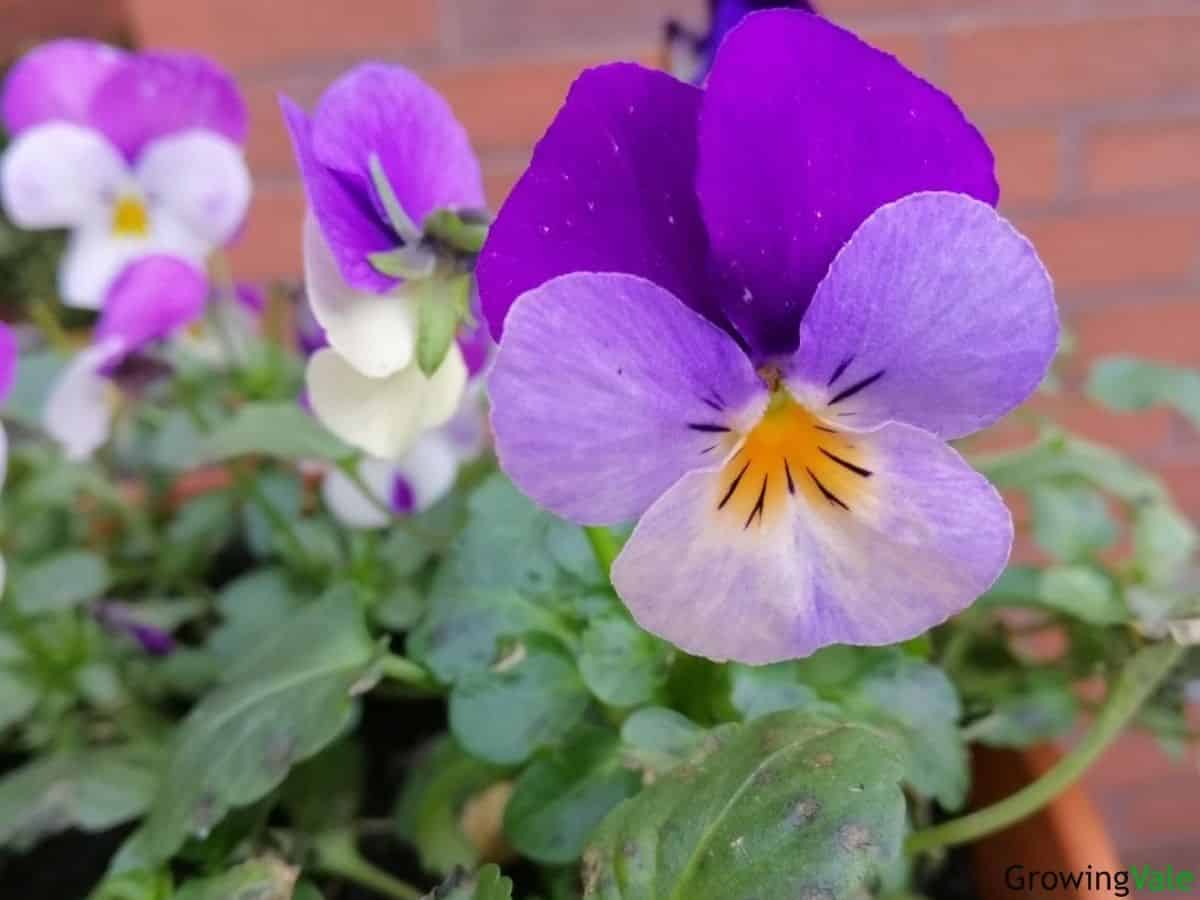The genus Viola is a large group that contains over 500 species of herbaceous plants and small shrubs. It belongs to the violet family, Violaceae, and there are several popular flowering plants within the genus! These can be separated into distinctive garden types: pansies (Viola x wittrockiana); Violets (Viola odorata, Viola riviniana, V. cornuta, and others); and Johnny-jump-ups (Viola tricolor and others).
Violas can be annuals, biennials, or perennials (deciduous or evergreen), but the garden varieties are normally grown as annuals or short-lived perennials. They are highly recognizable by their 5-petaled flowers that have a distinctive shape.
Violas are generally cool-season bloomers, although some species may bloom over the summer. Most wild species bloom in early spring, but many violas and their cultivars bloom over winter, fall, and possibly summer too. Garden types such as pansies and Johnny-jump-ups are hugely popular as winter/spring garden plants.
History
Viola flowers can be found growing naturally worldwide, however, they are typically found growing in temperate climates, with a large number occurring in the Andes Mountains in South America.
Garden types have been heavily cultivated for their pretty flowers, leading to hundreds of hybrids and cultivars. This is what led to the development of pansies, a hugely popular flower amongst gardeners! They were bred in the early 1800s in Buckinghamshire, England, by crossing several viola species.
Violas have a rich history, and were used by the Greeks as early as the 4th century B.C. as a medicinal herb! Viola is even a name of a character in Shakespeare’s Twelfth Night and several viola species have been referenced in his works. In A Midsummer Night’s Dream, Oberon sends Puck to gather “a little western flower” (Viola tricolor or heartsease) as an ingredient for a love potion!
Many species have showy flowers, some of which are sweetly scented. Their flowers vary in size depending on the species or variety, for example, pansies are known for having relatively large blooms, whereas Johnny-jump-ups have smaller flowers but tend to be more floriferous!
Garden variety violas are well-suited for both container and bed planting. Their flowers come in a myriad of pretty shades and color combinations, with white, pink, red, orange, yellow, blue, purple, and even black violas available.
Plant Facts
| Scientific name | Viola spp. |
| Common names | Viola, Violet, Johnny-jump-up, Pansy, Heartsease, Lady’s Delight |
| Genus | Viola |
| Family | Violaceae |
| Height | 0 ft. 6 in. – 1 ft. 0 in. |
| Width | 0 ft. 8 in. – 1 ft. 0 in. |
| USDA Plant Hardiness Zone | 4 – 11 |
| Origin | Worldwide, temperate climates |
| Flower colors | White, Pink, Red, Yellow, Orange, Purple, Blue, Black, Bi-color, Multicolor |
| Blooming season | Spring, Fall, and Winter depending on species/variety |
| Plant/Flower special features | Showy, fragrant flowers, popular for winter gardens |
How to Plant and Grow Violas
Since the viola group is quite varied, planting time, as well as the blooming season will vary between species and varieties.
Violets are generally quite hardy so can be planted at any time of the year, weather and soil permitting. Pansies and Johnny-jump-ups on the other hand prefer cooler climates and should either be planted in early spring once the ground has thawed or in fall.
Violas are easily started from seeds, but for gardeners who simply don’t have the time, they are easily purchased in nurseries, garden centers, or online, ready to be planted out! The method for planting is very similar across all plants, although spacing should be altered accordingly with plant size.

Growing Viola Flowers in Beds
Viola plants are easy to grow and once established need little care. First, prepare the garden bed by thoroughly de-weeding and gently turning up the soil. Take time to remove large stones or clumps of dirt. At this stage, amend the soil if it is required.
Dig holes that are deep enough and wide enough to house the roots of the plant. For those opting to use fertilizer, mix a slow-release fertilizer into the ground following package instructions. Gently teases out the violas from their containers and plants them into the ground at the same depth they were previously growing. Fill in the soil around the plants and gently firm it down.
Water well to settle them in, avoiding splashing water on any flowers or foliage to avoid disease. Plant violets, smaller flowered pansies, and Johnny-jump-ups at least 6 inches apart. Larger flowered pansies should be planted 10-12 inches apart.
Growing Viola Flowers in Containers
Violas are wonderful as container plants and look fantastic planted with a diverse range of flowers in window boxes! They are perfect for bringing color to balconies, courtyards, and patios.
For pansies and Johnny-jump-ups planted in fall, choose a plastic or glazed ceramic pot that can withstand cold temperatures. Otherwise, clay and concrete pots are fine. Make sure the container has enough drainage holes to prevent the soils from becoming cold or waterlogged and causing root rot!
Use a well-draining potting mix, leaving a 1-inch gap between the top of the soil and the rim of the pot. Then, plant the violas in the same way they are planted in beds and borders. Container-grown plants would benefit from fertilization with a liquid fertilizer every 1- 4 weeks following the manufacturer’s guidelines.

How to Propagate Viola Plant
Violas are easily propagated by seeds, however, some species can also be propagated from cuttings or by division! Pansies and Johnny-jump-ups should either be started indoors 10-12 weeks before the last spring frost for planting out in spring or can be sown directly outdoors from May to July.
For violets that need a cold period for germination such as V. odorata or V. cornuta they can be sowed outdoors from late summer to early fall, otherwise, sow violet seeds in spring. If unsure, the guidelines on the back of the seed packet should offer more guidance.
Bear in mind that some hybrids may not set seeds, and if collecting seeds from existing plants in the garden, viola plants hybridize very easily and potential offspring may not have the characteristics of the parent plant!
Sowing Viola Seed Indoors
Use this method for pansies and Johnny-jump-ups. Fill a tray with seeding mix. Scatter the seeds on top of the soil, then give them a light covering of compost. Moisten the soil a little before covering the tray and putting it in the refrigerator for two weeks.
Once two weeks have gone by, move the tray into a dark, heated space that has a temperature between 65 and 70°F. Germination should occur within 2 – 3 weeks. Once the seeds have germinated, they should be moved next to a sunny window or placed under grow lights. Be sure to move the grow lights up as the seedlings grow. Thin out the seedlings once the first true pair of leaves develop.
Plant the seedlings out in spring, making sure to harden them off.
Sowing Viola Seeds Outdoors
A common problem with viola seeds sown outdoors is the seeds being washed away by the rain. To increase the chances of success, sow them in outdoor pots in a sheltered spot and select a dry day for sowing.
First, prepare the planting area by thoroughly de-weeding. Rake the top of the soil to loosen it up slightly. Sow the seeds on top of the soil and follow with a light sprinkling of soil on top. Water the seeds using a watering can fitted with a rose sprinkler head. This will reduce the chances of the seeds being washed away.
Once they have germinated, thin seedlings out leaving only the strong plants. They may need to be protected with horticultural fleece during frosty weather. While the seedlings are small, continue to remove any weeds to reduce competition. Once the violas are well-established, they should be able to overpower any weeds.
Propagating Violas by Division
Perennial violas such as V. odorata and V. cornuta can be divided in early spring or late fall. Cut back the plant by half before dividing it to minimize stress on the plant.
Propagating Violas from Cuttings
Propagating violas from cuttings is a great way to ensure the new viola plant is identical to the parent plant! They are easy to propagate in this way and should be done so in the summer months by taking 3-inch cuttings from new growth.
Fill a seed tray with a 1:1 mixture of coarse grit and seeding mix. Then, remove the lower leaves from the cuttings before gently pushing the cuttings, cut side down, around two-thirds into the soil. Water them well once, then keep the soil moist. The cuttings should root quickly and without any need for heat. Once they have rooted, they can be potted into larger containers.

Violet Flower Care and Maintenance
Here are some helpful tips to care for your viola plants:
Soil
Plant violas in consistently moist soil that is well-draining and humusy. If indeed, amend the soil with organic matter.
Water
Give violas water regularly, they should receive at least 1-inch of water a week (either from rain or watering). Take care not to water them too much as they are prone to root rot.
Give winter plants a good watering before the ground freezes so their roots get enough water.
Fertilizer
Add a slow-release fertilizer into the soil during planting, then fertilize them again halfway through the growing season using a 5-10-10 fertilizer. A water-soluble fertilizer can be used instead, every 1 – 4 weeks following the manufacturer’s instructions.
Mulch violas with a thick layer of organic material to conserve moisture in the soil and keep it cool during hot weather.
Sunlight
Viola plants grow best in full sun to partial shade.
Temperature and Humidity
Violas are cool weather plants that don’t do well in the heat of the summer. They do best when soil temperatures are between 45 and 65°F. Many are frost tolerant and will bloom over winter. In some cases, they will stop flowering in the heat of summer but with proper care can bloom again in fall when temperatures drop.
Pest and diseases
While generally trouble-free, violet flowers are prone to powdery mildew, gray mold, and fungal leaf spots. The best way to minimize these risks is to have good airflow between plants and to avoid splashing water on their flowers and foliage.
Pruning
Most violas can be deadheaded to prolong the flowering season and encourage more blooms! Deadhead blooms by cutting plants back to 3-4 inches, this is a great way to rejuvenate plants. Toward the end of the blooming season, stop deadheading the violas to allow them to self seed if desired!
Toxicity
Pansies are mildly toxic to dogs.
Uses of Violet Flower
Many violas such as pansies, Johnny-jump-ups, and V. odorata are edible in small amounts! They are often crystallized in sugar and used as cake decoration or eaten raw. They can also be dried and used in potpourri.
Common Varieties and Cultivars
Here are some popular types of violets:
- Dog-violet (V. riviniana) – Dog-violets are perfect for woodland or shade gardens. These violas can grow in full sun to part shade and have delicate yet showy flowers.
- Horned Violet (V. cornuta) – Viola cornuta or horned violets are easy-to-grow plants. They bloom over spring and summer and their flowers have a slightly sweet scent. This viola flower looks wonderful in patio containers planted alongside other colorful viola cultivars!
- Johnny-jump-ups (V. tricolor) – Also called heartsease or wild pansy, these violas are similar to pansies but have smaller flowers. They can be biennials or short-lived, evergreen perennials, but they are often grown as small-flowered annuals. Johnny-jump-ups look lovely planted with other species and viola cultivars.
- Common Blue Violet (V. sororia) – Viola sororia, also known as the common blue violet or the woolly blue violet is a perennial viola with deep violet flowers! Its small blooms look fantastic in rock, cottage-style, or coastal gardens.
- Pansy (V. x wittrockiana) – Pansy flower is one of the most well-known violas. They have relatively large flowers and are brilliant for winter displays! There are trailing cultivars available, making them a top choice for hanging baskets.
- Sweet Violet (V. odorata) – Sweet violets have a wonderful sweet aroma and have a spreading habit so are great for adding ground cover! Their fresh blooms are well-suited for cottage-style gardens and come in delicate shades of white, purple, blue, and pink. Their heart-shaped leaves are rich green and contrast nicely with their flowers.
Conclusion
Violas belong to a large genus of over 500 species. They can be annuals, biennials, perennials, or shrubs, with several species being popular garden ornamentals! Within the garden varieties, there are distinct groups, pansies, Johnny-jump-ups, and violets.
Their 5-petaled flowers are showy and can be sweetly scented depending on the species. Violas are cool-season plants with many varieties being prized for winter displays, however, some species begin blooming in spring and can continue into summer. In climates that experience hot summers, they may stop blooming, but with proper care can have a second bloom in the fall!
Their showy flowers come in different sizes and a myriad of lovely shades. They can be white, pink, red, yellow, orange, blue, purple, and even black. Black-colored and multicolored varieties also exist! Violas are brilliant in containers, beds, and borders, and look lovely in cottage-style, patios, and container gardens.
See more: Violet flower meaning

